

The ultimate guide on how to become an expert in app retention & engagement
The ultimate guide on how to become an expert in app retention & engagement

This guide dives deep into the strategies that transform user engagement and retention for mobile apps.
User retention & app engagement is becoming crucial for apps that want to survive in this market. The rising costs and struggles of user acquisition combined with an increasingly more competitive market make it hard for apps to not only gain new users but also keep them engaged. That’s why StriveCloud is creating the ultimate guide to app engagement! We’ll walk you through some awesome app gamification examples and teach you how we dropped user churn by 23%!
Find out why you need to up your user engagement to combat churn, and how gamification for apps can help you! Here’s what we’ll cover:
- How to increase mobile app engagement & limit user churn in 2022
- The lifecycle of mobile app users, from user activation to loyal user
- 3 app engagement & retention metrics you need to know
- 3 tactics successful apps use to boost user activation & engagement
- 5 gamification examples from apps that reduced user churn
- 3 gamification examples from apps that skyrocketed user engagement
- FAQ - the quick answers to your biggest questions
How to increase mobile app engagement & limit user churn in 2022
Why is user retention and engagement so important for apps in 2022?
Simply put, today’s consumers crave engagement - the average person spends 1/3 of their waking hours on mobile! And that number is still rising, along with consumer spend and app downloads. In short, app engagement is key to achieving your app business goals.
To create engagement, your app has to be sticky, meaning users can’t help but return! For product growth managers, stickiness tells you how valuable and habit-forming your app is - essential traits to reduce user churn. You can achieve this with app gamification.
The lifecycle of mobile app users, from user activation to loyal user
The first step in making your app sticky is optimizing the customer journey. Sure, the task is intimidating when viewed from the big picture, but the mobile app funnel can help clarify the process and the actions you need to take.
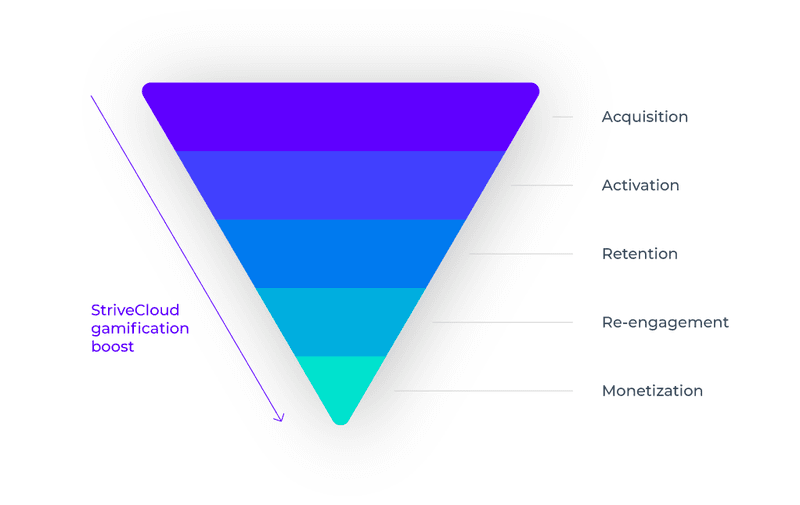
This diagram illustrates the user lifecycle funnel, from initial acquisition to becoming a loyal, engaged user.
1. User acquisition and the need to increase your user base
In 2021, it cost on average $1.22 to acquire a user - and that number is still rising. Moreover, you'll waste that money unless you segment your audience right. Of course, that's given your app store page is optimized and you appear in searches.
2. User activation and app engagement
User activation is the ultimate bottleneck for apps. Today, 75% of users quit on Day 1 after installation! Instead, you must show users your value proposition or how they benefit from your app. For one, this means developing a user-friendly onboarding.
But the benefits to your business are clear - a 25% uplift to user activation results in a 34% revenue boost!
3. User retention and habit formation
Moving down the line, Day 30 user retention sits at a meager 3.1%. The solution here is to create a sticky, habit-forming app. A gamified app has an advantage because app gamification makes the UX more fun, rewarding, and unpredictable. In other words, it keeps users coming back for more!
Gamify your app, 1 building block at a time! Discover how to instantly drop user churn by 23% with our app gamification platform!
4. User re-engagement to slash churn
To win back those lost in the retention stage, you need a re-engagement strategy. This means giving your users value once more, but without adding clutter to their lives. Returning users don’t just cost less to re-engage, they also purchase 37% more than organic acquisitions!
5. User engagement & monetization strategy
The success of your monetization strategy depends on which model you choose. Some apps use freemium models and try to convert those into paying customers. Others are free or paid off the hook! Whether you earn through subscriptions, adverts, or in-app purchases, it all depends on what your audience prefers and the frequency at which they use your app.
3 app engagement & retention metrics you need to know
There are many ways to measure your success in user engagement and retention, but you need to understand how to utilize them all together to get a clear picture:
1. Active users
Activate users are the people actively engaging or interacting with your app. This can be on a daily, weekly, or monthly basis depending on the usage frequency of your app. Knowing your active users can tell you a lot about the state of your app engagement strategy. Daily usage could indicate successes, whereas monthly users might show shortcomings.
2. App session length
App session is the length of time a user spends on your app and can clearly indicate individual engagement levels. A related metric - and one you want to keep as low as possible - is bounce rate, when users quit fast after opening.
3. App session intervals
App session intervals track the time in between consecutive sessions. The lower these get, the better your app engagement is. In fact, tracking the intervals between app sessions can tell you if your user is hooked. This is crucial in knowing where to place them on the customer journey!
With these metrics, you can measure product stickiness. This is an important indicator of app engagement and product health. Subscription-based businesses especially need to pay attention to this. If you fail to create a habitual experience, user churn will eventually happen.
3 tactics successful apps use to boost user activation & engagement
1. How an in-app community maximizes user retention
In-app communities have an incredibly powerful effect on user retention. By encouraging users to interact, you fulfill the need to socialize and create customer motivation. In fact, communities can increase customer loyalty by more than half!
2. How contextual notifications drive app engagement
Personalizing your interactions with each user can transform your app engagement strategy. Engaging with users in a way suited to their habits, needs, and activity creates customer value - and can lift your push notification conversion rate by 40%.
3. Why gamification for apps is the ultimate retention strategy
App gamification augments your strategy from activation to monetization. Studies show a 54% rise in free trial usage when it’s a gamified app. If we look at other successful gamification examples, we learn features like leaderboard, progress bars or daily streaks make the UX really exciting - and harder to quit.
5 gamification examples from apps that reduced user churn
Without a good user engagement strategy, you’ll have a small chance of achieving the level of user retention you want. But app gamification can help:
1. Challenges empower user activation
Enhancing user engagement: The role of gamification in mobile apps - "Gamification examples such as challenges have been shown to evoke feelings of freedom in users and, thus, perceptions of higher autonomy"
In short, challenges empower your users by fulfilling their need for personal competence. As a result, you reward them with a self-confidence boost leading to higher user activation! The instant feedback paired with social interaction makes users more likely to engage again in the future.
2. Gamified onboarding reduces user churn
Let’s face it, long onboarding procedures are frustrating and it shows its effect on user churn more likely. In fact, user retention rates can jump 50% with gamified onboarding. Progress bars are a huge part of this. The visualization of progress provides users with instant feedback and clearly tells them what’s expected next. Another advantage that gamified apps have.
3. Badges reduce user churn through positive reinforcement
Badge reward systems are a form of feedback called positive reinforcement, and they motivate users to continue! For sure, seeing that your efforts are recognized in the community goes a long way. Indeed, research shows that ‘status feedback’ positively influences user retention.
4. Points fuel app engagement & user retention
Points act as a powerful reward for simple actions a user takes on your app. These points can serve as the fuel for your gamified app. You can exchange points for rewards, and base other gamification features around it like leaderboards, raffles, and even leveling systems!
5. Leveling systems elevate user retention through a feeling of ownership
Give users a sense of ownership and progress by introducing a leveling system. This gives a wide range of opportunities to personalize your experiences and spur user engagement. For instance, let your users choose their own profile pictures or create their own avatars. A 2021 study showed that avatars satisfy the needs for competence, autonomy, and social relatedness, in turn influencing reuse intention. Put simply, avatars provide a sense of ownership.
3 gamification examples from apps that skyrocketed user engagement
1. An in-app community gifts Insight Timer the best user retention of all wellness apps
In the US, Insight Timer makes up a whopping 63% of all time spent on meditation apps! How do they do achieve such high retention and user engagement rates?
Insight Timer limits user churn by building a global community of meditators. Right away, the home screen is a world map of users meditating that very moment, making customers feel a part of a bigger movement. Studies show that socialization is a powerful motivator since people naturally want to belong to something greater than themselves.
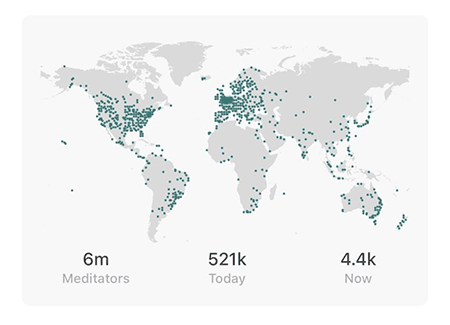
Insight Timer effectively shows a global community of users, which fosters a powerful sense of belonging and social connection.
Get started on your own gamification journey today! Book a custom gamification workshop & create your own roadmap!
2. Users of fintech app Qapital can set targets to save
Let your users set financial goals and time targets, and you will give them ownership over their personal journey. By personalizing the app, you provide customer value. Moreover, case studies show that adding a deadline greatly helps goal pursuit!
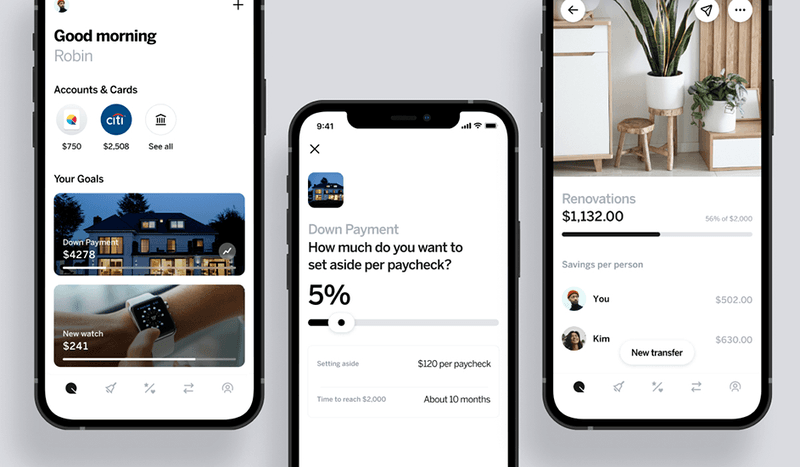
Qapital's goal-setting feature empowers users by giving them direct control over their financial journey, making savings more tangible.
3. How HumanForest’s gamified app rewards app engagement
HumanForest is a sustainable, shared e-bike service that aims to reduce carbon emissions! They have a gamified app where users earn TreeCoins every time they ride an e-bike. This in-app currency represents the number of trees saved in CO2 emissions, and can buy discounts and free rides! It’s a brilliant gamification example (and here’s why!)
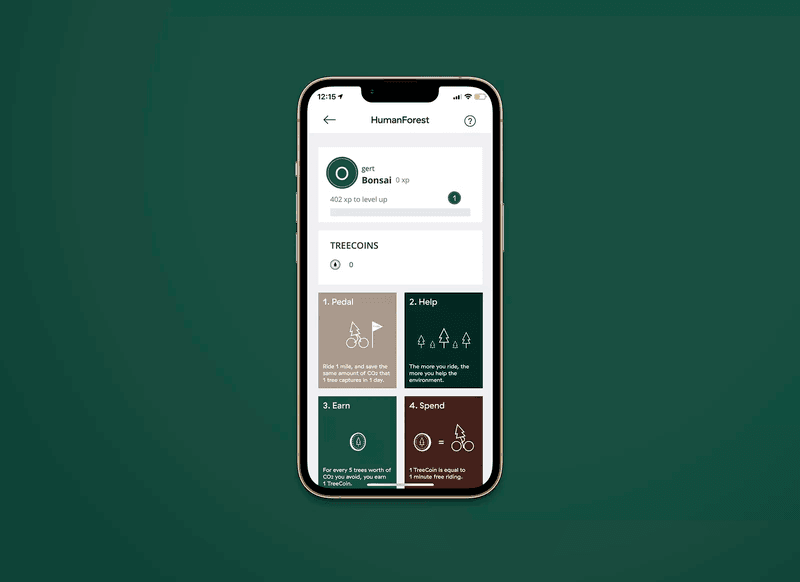
HumanForest's app demonstrates an effective use of in-app currency to reward sustainable behaviors and keep users engaged.
FAQ - the quick answers to your biggest questions
Why is user engagement and retention so important for apps in 2022?
The average person spends 1/3 of their waking hours on mobile - illustrating not just the potential opportunities for your app, but also underlining how worthwhile and valuable app engagement is to users in 2022.
How can you increase user activation & limit user churn?
There are many challenges in the customer journey. From getting noticed in the app store to activating new users with free trials (that won't bankrupt you!). Building a sticky experience that prevents user churn is not easy!
How do I measure success for my user retention and app engagement goals?
Using metrics like the number of daily, weekly, and monthly active users, you can see who interacts with your app, and importantly when they do so. In further detail, data on app session length and intervals can show how engaged users are.
What can you learn from these gamification examples?
App gamification works for any vertical, whether you're in fintech, health, or mobility. Leaderboards fulfill a user's need to grow and experience competence. Next, badges act as a form of motivational instant feedback. Finally, points can serve as an exciting reward but also fuel unpredictability through things like raffles!
Related Posts
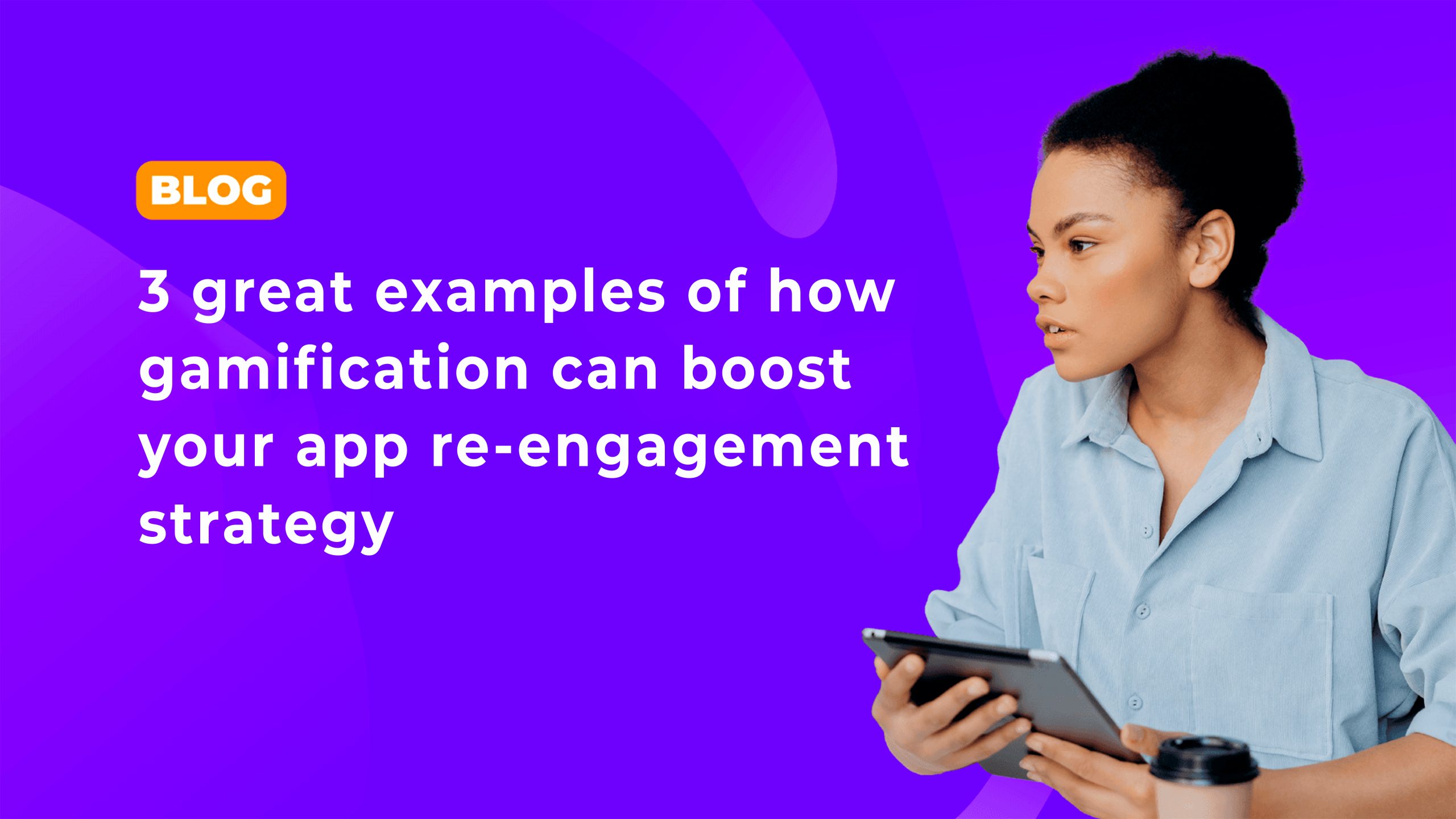
3 great examples of how gamification can boost your app re-engagement strategy
User acquisition costs are on the rise. In 2021, it cost on average $1.22. Given this, user retention is more important than ever, and one of the best things you can do to improve it is to optimize your re-engagement strategy. Read on to get started!
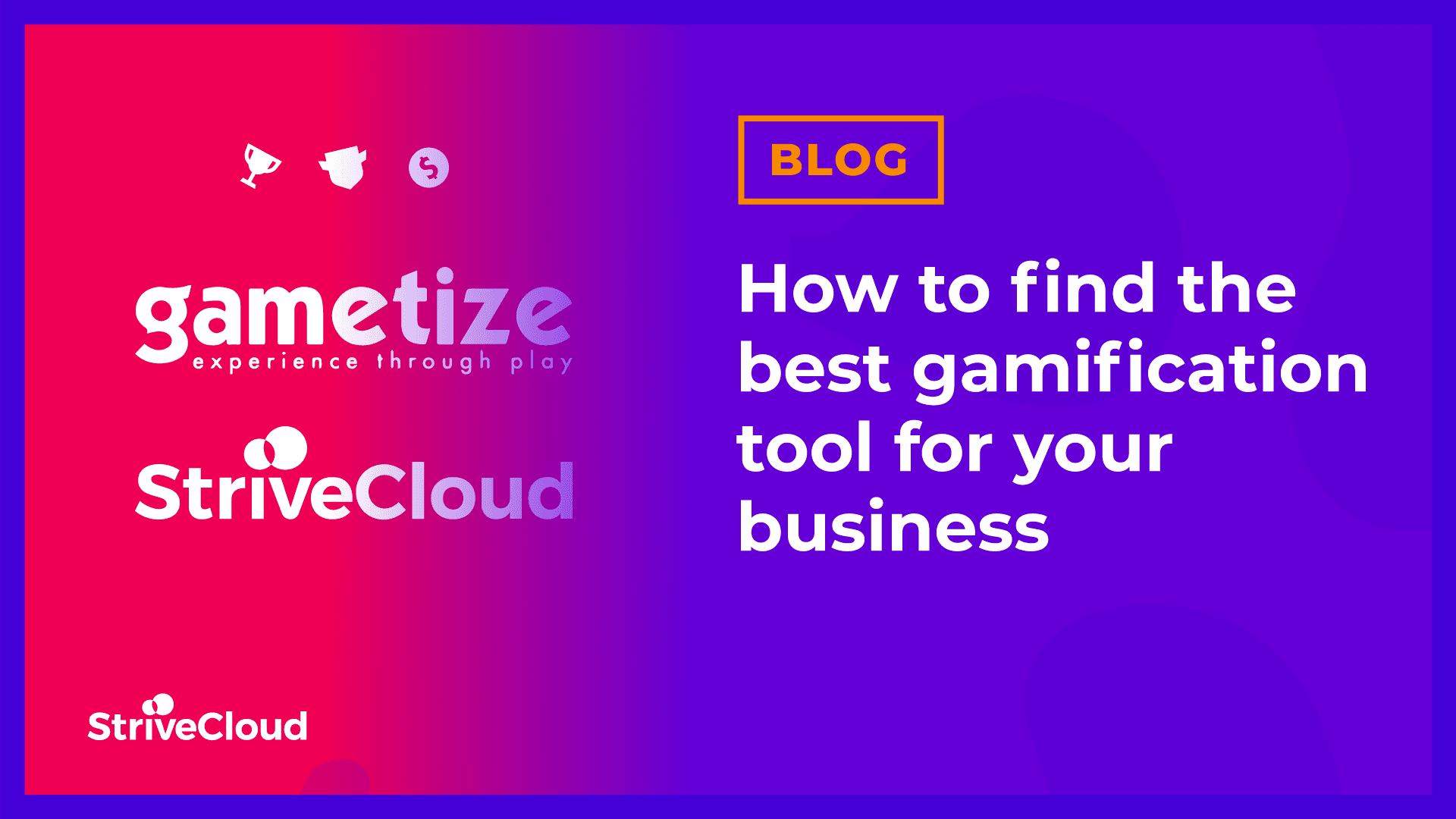
How to find the best gamification tool for your business
Gamification helps you create digital experiences that get users hooked. However, picking the right tool can be a great challenge. In this post we compared two of the leading gamification solutions out there on price, features and level of support. Want to find out which tool will help you achieve your business goals? Find out in the blog!

